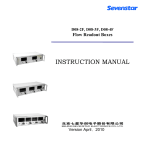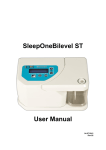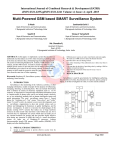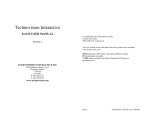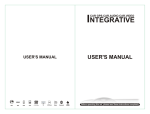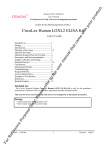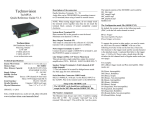Download Internet Based Embedded Data Acquisition System
Transcript
a International Journal of Electronics Communication and Computer Engineering Volume 5, Issue (4) July, Technovision-2014, ISSN 2249–071X Technovision-2014: 1st International Conference at SITS, Narhe, Pune on April 5-6, 2014 Internet Based Embedded Data Acquisition System Priti. G. Pachpande Asst. Prof. S. P. Dhanure Department of Electronics & Telecommunication Sinhgad Institute of Technology and Science, Narhe Pune, Maharashtra, India Email: [email protected] Department of Electronics & Telecommunication Sinhgad Institute of Technology and Science, Narhe Pune, Maharashtra, India. Email: [email protected] Abstract – This paper realizes an embedded web server, which enables data acquisition and status monitoring with the help of any standard web browser. Biggest advantage of this web server is embedding a PC based web advantage server into the ARM platform without losing any of its features. It consists of application program written in C accessing data through the serial port and updating the web page, porting of Linux 2.6.3x Kernel with application program on ARM9 board and booting it from the RAM. working statistics, configuration and operation results, to a Web browser. EWSs are also used to control or transfer user commands from a Web browser to an embedded system. The state information is extracted from an embedded system Application and the control command is implemented through the embedded system application. Embedded web software to be light weighted version of web software in many instances. Embedded web servers have different requirements, such as low resource usage, Keywords – ARM, Linux, Embedded Web Server, Internet. high reliability, security and portability, for which general web server technologies are unsuitable. system brings the advantage of performance, reliability, availability and I. INTRODUCTION support from large developing community. High As the World-Wide Web (WWW) continues to evolve, performance ARM Processor further enhances the quality it is clear that its underlying technologies are useful for of features offered by the web server. This paper introduces a solution for embedded system much more than just browsing the web. Web access functionality is embedded in a device to enable low cost access to Internet, through which we can remote access, widely accessible and enhanced user interface functions monitor, maintain conveniently. The solution is based on for the device. A web server in the device provides access Web and embedded technology DAQ (Data Acquisition) to the user interface functions for the device through a is the process of bringing a real-world signal into the device web page. A web server can be embedded into any computer, for processing, analysis, storage and data appliance and connected to the Internet so the appliance manipulation. Today, most scientists and engineers are can be monitored and controlled from remote places using personal computers with ISA, EISA, PCI or through the browser in a desktop. This brings in a need for PCMCIA bus for data acquisition in laboratory to test and and industrial automation. As web services being deployed on various embedded measurement, processors such as Advanced RISC Machine (ARM) in instrumentation field entering into a fourth generation, i.e. remote controlling based on Ethernet and Internet. It is real time context. Usage of Linux as he operating system. Embedded web server refers to import WebServer at the boon to instrument having such provision for remote scene the monitor and control equipment, in the support of controlling. Data Acquisition System (DAQ) plays a vital appropriate hardware platforms and software systems, role in instrumentation where interfacing with PC. transfer traditional monitor and control equipment into an Embedded systems control many devices in common use internet based, possessed with TCP/IP protocol as the today and are usually build dedicated to perform a specific underlying communication protocol and Web server task. Design engineers can optimize it to reduce the size and cost of the product and increase the reliability A technology as its core[1]. General web servers, which were developed for general typical Data acquisition system (DAS) consists of purpose computers such as NT servers or Unix and Linux individual sensors with the necessary signal conditioning, workstations, typically require megabytes of memory, a data conversion, data processing, multiplexing ,data fast processor, a pre-emptive multitasking operating handling and associated transmission , storage and display system, and other resources. A Web server can be data. DAS is very useful in keeping track of data from embedded in a device to provide remote access to the sensors recording values from the environment in real time device from a Web browser if the resource requirements of .In order to optimize the characteristics of the system in the Web server are reduced. The embedded system can be terms of handling capacity and cost. Analog data is utilized to serve the embedded web documents, including generally acquired and converted into digital form for the static and dynamic information about embedded systems, purpose of processing, transmission, display and storage. to Web browsers. This type of web server is called an The Primary goal of building a Internet connected Data Acquisition system is to build a DAS which would be able Embedded Web Server (EWS)[2]. The main use of EWS is to convey the current state to acquire the necessary data from sensors , at correct Information of embedded systems, such as a system’s speed and at a correct time and upload and record the All copyrights Reserved by Technovision-2014, Department of Electronics and Telecommunication Engineering, Sinhgad Institute of Technology and Science, Narhe Pune Published by IJECCE (www.ijecce.org) 46 International Journal of Electronics Communication and Computer Engineering Volume 5, Issue (4) July, Technovision-2014, ISSN 2249–071X a Technovision-2014: 1st International Conference at SITS, Narhe, Pune on April 5-6, 2014 values up on an external server through internet . So that a system values can be monitored from anywhere without the need of special equipments to receive and display information in condensed, understandable and legible manner. A user may also be able to diagnose the problem and could even set it right. The information can easily be accessed and controlled by PC or PDA with internet access, which in turn can be connected to a local low cost local area network (LAN) to transfer sensor values directly to a data logger or computer. The accessibility of this information is significantly curtailed by this need for proximity. However, developments in the Internet protocol, TCP/IP, which is the universal communication standard, looks, set to change all of this. In order to allow communications to be directed, every physical location on the Internet (server or client) requires an IP address. Software have been designed to run in PDA or PC that passes messages received on an IP network to the logger hardware via a serial port or USB or through GPRS, Bluetooth , Zigbee etc. II. BLOCK DIAGRAM The block diagram of the system of DAQ is shown in the above fig.1. The system consists of the following units viz. Camera, GPS, GPRS, ARM 9 processor. Fig.1. Remote Monitoring & Control of Industrial Parameters through ARM 9 processor & GSM Module A. ARM 9Processor The general hardware structure of the remote I/O data acquisition and control system based on ARM 9 processor. The remote I/O data acquisition and control system based on embedded ARM platform has high universality. Sensors are used for process monitoring and for process control. Each I/O channel can select a variety of electrical and non electrical signals like current, voltage, resistance etc. Multiple sensors can be used to measured data are stored in external memory, we can directly show this data on LCD display connected to port 0 & the memory is act as a data base during accessing web server. We can interface GUI with this processor. B. GPS (Geo-Positioning System) A GPS receiver is fully-functional satellite navigation system. More than two dozen GPS satellites are in medium earth orbit, transmitting signals allowing GPS receivers to determine the receiver's location, speed and direction. Each of these 3,000- to 4,000-pound solar powered satellites circles the globe at about 12,000 miles (19,300 km), making two complete rotations every day. The orbits are arranged so that at anytime, anywhere on earth, there are at least four satellites "visible" in the sky. The location of at least three satellites above it The distance between the receiver and each of those satellites. The GPS receiver figures both of these things out by analyzing high-frequency, low-power radio signals from the GPS satellites. Better units have multiple receivers, so they can pick up signals from several satellites simultaneously. Radio waves being electromagnetic energy, travel at the speed of light (about 186,000 miles per second, 300,000 km per second in a vacuum). The GPS receiver system uses a micro strip patch antenna, followed immediately by a low noise amplifier. These two together form an integrated active antenna, having an overall gain of 26dB. This antenna is interconnected to the receiver through a 50 ohm RF cable of 10m length. The M, activation of GPS is simple and is achieved by providing it with a 12 v power supply. NMEA 0183 (or NMEA) is a combined electrical and data specification for communication between marine electronics and GPS receivers. The NMEA protocol is a means by which marine instruments and GPS receivers can communicate with each other. It has been defined by, and is controlled by, the US based National Marine Electronics Association. The NMEA standard uses a simple ASCII, serial communications protocol that defines how data is transmitted in a "sentence” or a string. The standard also defines the contents of each sentence (message) type so that all listeners can parse messages accurately: Each message starting character is a dollar sign. The next first five characters identify the type of message. All data fields that follow are comma-delimited. The first character that immediately follows the last data field character is an asterisk. The asterisk is immediately followed by a two digit checksum. C. Camera This project implements a WEBCAM with TCP/IP capability using ARM microcontroller. The photos are taken with a VGA Camera and JPEG compression. The host can send a snapshot command in order to capture a full resolution single-frame still picture. The picture is then compressed by the JPEG engine and transferred to the host. Each photo is divided in 64 bytes segments. An GSM/GPRS module is used to transmit these packets over the internet. A windows based program is used to receive the packets. The programming language that was used is Microsoft Visual Basic 6, a simple and widespread language. With this program the user will be able to: All copyrights Reserved by Technovision-2014, Department of Electronics and Telecommunication Engineering, Sinhgad Institute of Technology and Science, Narhe Pune Published by IJECCE (www.ijecce.org) 47 International Journal of Electronics Communication and Computer Engineering Volume 5, Issue (4) July, Technovision-2014, ISSN 2249–071X a Technovision-2014: 1st International Conference at SITS, Narhe, Pune on April 5-6, 2014 1. Take a picture at resolution of 640x480 or 320x240 2. Change the camera’s IP and gateway address match his network With this system will also track a vehicle to enable the owner or a third party to track the vehicle's location. Most modern vehicle tracking systems use Global Positioning System (GPS) modules for accurate location of the vehicle. Many systems also combine a communications component such as cellular or satellite transmitters to communicate the vehicle’s location to a remote user. Vehicle information can be viewed on electronic maps via the Internet or specialized software. Current vehicle tracking systems have their roots in the shipping industry. Corporations with large fleets of vehicles required some sort of system to determine where each vehicle was at any given time. Vehicle tracking systems can now also be found in consumers vehicles as a theft prevention and retrieval device. Police can follow the signal emitted by the tracking system to locate a stolen vehicle. Many vehicle tracking systems are now using or a form of automatic vehicle location (AVL) to allow for easy location of the vehicle. The GPS satellite system was built and is maintained by government and is available at no cost to civilians. This makes this technology very inexpensive. Other AVL systems do not require the antenna to be in direct line of sight with the sky. Terrestrial based systems such as LORAN and LoJack tracking units use radio frequency (RF) transmitters which will transmit through walls, garages, or buildings. Many police cruisers around the world have a form of AVL tracking as standard equipment in their vehicles. Some vehicle tracking systems charge the user a monthly subscription for a bundle that includes mapping software, hardware, installation, and tracking service. Other companies offer units that are paid for upon installation and will continue to work for the life of the vehicle. The decision to adopt an active technology based on RF (e.g. LORAN), satellite or public carrier (e.g.CDMA) is driven by the quantity of information, the frequency of updates, and the physical environment of the device. For example a fleet manager may want 5 minute updates, telling whether a vehicle is on or off, or may want 30 second updates tracking engine vitals, brake status, container status, vehicle speed and direction and so on. System Overview The System would involve the following components: GSM / GPRS Modem. GPS Device for NMEA Data. ARM7TDMI Board. An SQL Database for logging data. A Web server for hosting the Database. A webpage on which the tracing results will be displayed. Digital Maps. The Position coordinates sent by the GPS device will be logged by the ARM7TDMI Controller at periodic intervals. After processing the NMEA data, the data will be uploaded to the server via the GPRS/Internet Connection. The program resident on the server will process the data and map the position on a digital map. The digital map view can be accessed through and other PC’s using the HTTP Protocol, thus giving real time positioning of the vehicle. III. SOFTWARE USED A. Linux Operating System A lot of the advantages of Linux are a consequence of Linux' origins, deeply rooted in UNIX, except for the first advantage, of course: Linux is free: As in free beer, they say. If you want to spend absolutely nothing, you don't even have to pay the price of a CD. Linux can be downloaded in its entirety from the Internet completely for free. No registration fees, no costs per user, free updates, and freely available source code in case you want to change the behavior of your system. Most of all, Linux is free as in free speech: The license commonly used is the GNU Public License (GPL). The license says that anybody who may want to do so, has the right to change Linux and eventually to redistribute a changed version, on the one condition that the code is still available after redistribution. In practice, you are free to grab a kernel image, for instance to add support for teletransportation machines or time travel and sell your new code, as long as your customers can still have a copy of that code. Linux is portable to any hardware platform. B. HTTP Protocol The protocol used for the communication between web server and web browser is Hyper Text Transfer Protocol or HTTP protocol. This protocol defines all the basic frame work of web communications by handling requests and also by providing control information to be transferred between browser and server. To obtain a web document, the browser and server should establish a connection at Port. Establish a connection. To open a web document, client and server should establish their connection to port. This is done by means of sockets. Client will open a socket and bound it on a port. If successful, a virtual document is created where we can read and write. In the server side, firstly the socket is created and it is bound to the server address. Now the socket is converted to listening socket to hear the client request. After this the connection to the client is established. To handle multiple requests, server carries out several processes that prevent the communication interference. All copyrights Reserved by Technovision-2014, Department of Electronics and Telecommunication Engineering, Sinhgad Institute of Technology and Science, Narhe Pune Published by IJECCE (www.ijecce.org) 48 a International Journal of Electronics Communication and Computer Engineering Volume 5, Issue (4) July, Technovision-2014, ISSN 2249–071X Technovision-2014: 1st International Conference at SITS, Narhe, Pune on April 5-6, 2014 IV. EXPERIMENTAL RESULTS REFERENCES [1] [2] [3] [4] [5] [6] Fig.2. GPS Interface With ARM Microcontroller Board [7] [8] [9] [10] [11] Fig.3. Image obtained by Interfacing camera with ARM Microcontroller Board Above figure shows the interfacing of GPS and ARM 9 controller board and the GUI shows the exact longitude and latitude position of the GPS. Here the data is collected and further transferred. And the Fig No. 2 shows a image taken by the camera which further can be processed at the receiver end. [12] [13] [14] Yang Wang, Yaonan Zhang, Lihui Luo, and Guohui Zhao, “An e-Science Environment Study Using Wireless Transmission Technique”,Wireless Communicatins Networking and Mobile Computing, 2010, pp.1-4. Ali Ziya Alkar, Member, IEEE, and Mehmet Atif Karaca ” An Internet-Based Interactive Embedded Data-Acquisition System for Real-Time Applications” IEEE Transactions on Instrumentation and Measurement, VOL. 58, NO. 3, MARCH 2009.J. Clerk Maxwell, Atreatise On Electricity and Magnetism, 3rd ed., vol. 2. Oxford: Clarendon, 1892, pp.68–73. SIM 900 –RS232 GSM/GPRS Modem User Manual. C. E. Lin, C.-W. Hsu, Y.-S. Lee, and C. C. Li, “Verification of unmanned air vehicle flight control and surveillance using mobile communication,” J. erospace. Compute. Inf. Commun., vol. 1, no. 4, pp. 189–197, Apr. 2004. K. Jacker and J. McKinney, “TkDAS—A data acquisition system using RTLinux, COMEDI, and Tcl/Tk,” in Proc. Third Real-Time Linux Workshop, 2001. E. Siever, A. Weber, S. Figgins, and R. Love, Linux in a Nutshell. Sebastopol, CA: O’Reilly, 2005 J. E. Marca, C. R. Rindt, and M. G. Mcnally, “The tracer data collection system: Implementation and operational experience,” Inst. Transp. Studies, Univ. California, Irvine, CA, Uci-Its-AsWp-02-2, 2002. E. Bekiroglu and N. Daldal, “Remote control of an ultrasonic motor by using a GSM mobile phone,” Sens. Actuators A, Phys., vol. 120, no. 2,pp. 536–542, May 17, 2005. C. E. Lin and C.-C. Li, “A real-time GPRS surveillance system using the embedded system,” J. Aerosp. Comput. Inf. Commun., vol. 1, no. 1,pp. 44–59, Jan. 2004. C. Xiaorong, S. Zhan, and G. Zhenhua, “Research on remote data acquisition system based on GPRS,” in Proc. 8th ICEMI, 2007, pp. 2-20–2-23. M. A. Al-Taee, O. B. Khader, and N. A. Al-Saber, “Remote monitoring of vehicle diagnostics and location using a smart box with Global Positioning System and General Packet Radio Service,” in Proc. IEEE/ACS AICCSA, May 13–16, 2007, pp. 385–388. C. Zhang, J. Ge, H. Yu, and X. Zhang, “ET gravimeter data collecting system based on GPRS,” in Proc. 8th ICEMI, Jul. 18– Aug. 16, 2007,pp. 2-86–2-92. A. Sang, H. Lin, and C. E. Y. Z. Goua, “Wireless Internet-based measurement architecture for air quality monitoring,” in Proc. 21st IEEE IMTC, May 18–20, 2004, vol. 3, pp. 1901–1906. G. Zhenyu and J. C. Moulder, “An Internet based telemedicinesystem,” in Proc. IEEE EMBS Int. Conf. Inf. Technol. Appl. Biomed.,2000, pp. 99–103. V. CONCLUSION This system will provide a ubiquitously accessible; real time remotely monitored and controlled solution for automation of industries. Also use of ARM 9 Processor, web server, GSM module, Sensors & actuators provide existing possibilities. Thus this solution can be customized to suit any other industrial requirements related to monitoring and control provided by industrial sensor. It helps equipments maintenance and the sensor equipments improve the work efficiency. We describe the design process of sensor monitor system based on GPRS, the functional modules composing the monitor system, communication of monitor system and test results of system. All copyrights Reserved by Technovision-2014, Department of Electronics and Telecommunication Engineering, Sinhgad Institute of Technology and Science, Narhe Pune Published by IJECCE (www.ijecce.org) 49









